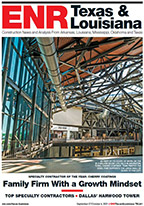Bolts removed from a tower crane being disassembled may have led to a fatal crash at the University of Texas at Dallas, according to safety experts. The accident occurred at the $60-million Arts and Technology Building on July 7, killing two workers. Officials with the U.S. Occupational Safety and Health Administration are investigating.
Photos published in local news reports show the tower lying across the building that was under construction, with two tower sections separated. At the time of the collapse, the jib already had been removed from the crane, a Terex Peiner Model SK415, says one expert familiar with the accident who asked not to be identified.
"There are no obvious signs of damage at the bolt connections," the source explains. "There should be damage to those connections or those areas would be bent, if the bolts were in there."
Terry McGettigan, president of Tower Crane Support, San Diego, agrees, adding that images published in the Dallas Morning News show at least six of the eight bolts on one connection stored in adjacent bolt racks, suggesting they were removed prematurely.
McGettigan claims that "de-torquing" of mast bolts has become a common practice in recent years, employed by some crews as a shortcut to speed the disassembly process. A strong weather front had rolled into the area, creating gusts of up to 40 miles per hour. However, McGettigan says wind would not have been a factor if the bolts were properly tightened.
"The mast would not have blown off if they had never loosened the bolts in the first place, let alone removed them," he says, adding that such de-torquing has been cited as a cause of other crane accidents, including a 2005 collapse at a high school in Worthing, U.K., which killed two people.

